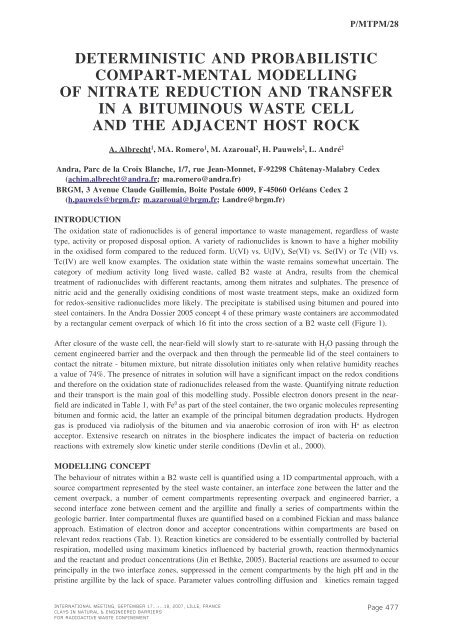Mass Transfer & Porous Media (MTPM) - Andra
Mass Transfer & Porous Media (MTPM) - Andra
Mass Transfer & Porous Media (MTPM) - Andra
Create successful ePaper yourself
Turn your PDF publications into a flip-book with our unique Google optimized e-Paper software.
P/<strong>MTPM</strong>/28DETERMINISTIC AND PROBABILISTICCOMPART-MENTAL MODELLINGOF NITRATE REDUCTION AND TRANSFERIN A BITUMINOUS WASTE CELLAND THE ADJACENT HOST ROCKA. Albrecht 1 , MA. Romero 1 , M. Azaroual 2 , H. Pauwels 2 , L. André 2<strong>Andra</strong>, Parc de la Croix Blanche, 1/7, rue Jean-Monnet, F-92298 Châtenay-Malabry Cedex( achim.albrecht@andra.fr ; ma.romero@andra.fr)BRGM, 3 Avenue Claude Guillemin, Boite Postale 6009, F-45060 Orléans Cedex 2( h.pauwels@brgm.fr ; m.azaroual@brgm.fr ; l.andre@brgm.fr)INTRODUCTIONThe oxidation state of radionuclides is of general importance to waste management, regardless of wastetype, activity or proposed disposal option. A variety of radionuclides is known to have a higher mobilityin the oxidised form compared to the reduced form. U(VI) vs. U(IV), Se(VI) vs. Se(IV) or Tc (VII) vs.Tc(IV) are well know examples. The oxidation state within the waste remains somewhat uncertain. Thecategory of medium activity long lived waste, called B2 waste at <strong>Andra</strong>, results from the chemicaltreatment of radionuclides with different reactants, among them nitrates and sulphates. The presence ofnitric acid and the generally oxidising conditions of most waste treatment steps, make an oxidized formfor redox-sensitive radionuclides more likely. The precipitate is stabilised using bitumen and poured intosteel containers. In the <strong>Andra</strong> Dossier 2005 concept 4 of these primary waste containers are accommodatedby a rectangular cement overpack of which 16 fit into the cross section of a B2 waste cell (Figure 1).After closure of the waste cell, the near-field will slowly start to re-saturate with H 2 O passing through thecement engineered barrier and the overpack and then through the permeable lid of the steel containers tocontact the nitrate - bitumen mixture, but nitrate dissolution initiates only when relative humidity reachesa value of 74%. The presence of nitrates in solution will have a significant impact on the redox conditionsand therefore on the oxidation state of radionuclides released from the waste. Quantifying nitrate reductionand their transport is the main goal of this modelling study. Possible electron donors present in the nearfieldare indicated in Table 1, with Fe 0 as part of the steel container, the two organic molecules representingbitumen and formic acid, the latter an example of the principal bitumen degradation products. Hydrogengas is produced via radiolysis of the bitumen and via anaerobic corrosion of iron with H + as electronacceptor. Extensive research on nitrates in the biosphere indicates the impact of bacteria on reductionreactions with extremely slow kinetic under sterile conditions (Devlin et al., 2000).MODELLING CONCEPTThe behaviour of nitrates within a B2 waste cell is quantified using a 1D compartmental approach, with asource compartment represented by the steel waste container, an interface zone between the latter and thecement overpack, a number of cement compartments representing overpack and engineered barrier, asecond interface zone between cement and the argillite and finally a series of compartments within thegeologic barrier. Inter compartmental fluxes are quantified based on a combined Fickian and mass balanceapproach. Estimation of electron donor and acceptor concentrations within compartments are based onrelevant redox reactions (Tab. 1). Reaction kinetics are considered to be essentially controlled by bacterialrespiration, modelled using maximum kinetics influenced by bacterial growth, reaction thermodynamicsand the reactant and product concentrations (Jin et Bethke, 2005). Bacterial reactions are assumed to occurprincipally in the two interface zones, suppressed in the cement compartments by the high pH and in thepristine argillite by the lack of space. Parameter values controlling diffusion and kinetics remain taggedINTERNATIONAL MEETING, SEPTEMBER 17...>...18, 2007, LILLE, FRANCECLAYS IN NATURAL & ENGINEERED BARRIERSFOR RADIOACTIVE WASTE CONFINEMENTPage 477
















